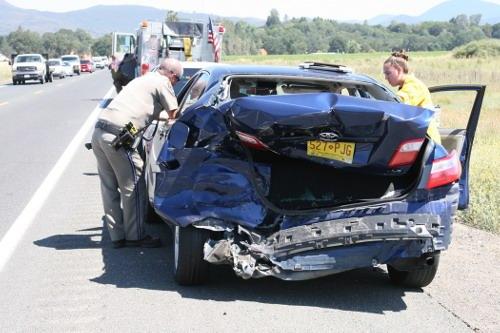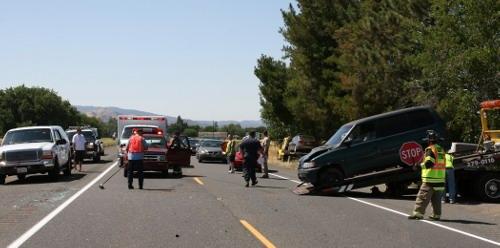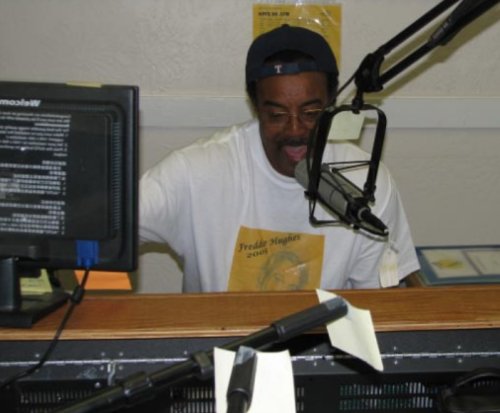LAKEPORT – The details of forensic testing, chain of evidence procedures and testimony from a former sheriff's sergeant who stated he was ordered not to give a breathalyzer test at a crash scene were discussed during testimony Wednesday in a trial over a fatal sailboat crash.
The second day of Bismarck Dinius' trial took place on Wednesday.
The 41-year-old Carmichael man is charged with felony boating under the influence causing great bodily injury and two lesser included offenses of boating with a blood alcohol level over 0.08 and boating while under the influence.
Dinius is alleged to have had a blood alcohol level of 0.12 while sitting at the tiller of Willows resident Mark Weber's sailboat, Beats Workin' II, on the night of April 29, 2006. The prosecution alleges that Dinius, by steering the boat, was responsible for operating it, and that he failed to have the boat's running lights turned on.
The sailboat was hit by a powerboat driven by an off-duty sheriff's chief deputy, Russell Perdock. Witnesses on Tuesday gave estimates that Perdock was driving his boat between 40 and 50 miles per hour that night, which was extremely dark and moonless.
Weber's girlfriend, 51-year-old Lynn Thornton, was mortally injured in the crash and died a few days later.
Establishing the custodial chain and testing of key pieces of evidence in the case – including blood samples from Dinius, Weber and Perdock – was a focus of much of the day's testimony.
Sheriff's Det. Jerry Pfann, who manages the agency's evidence storage, explained how he was contacted shortly before 2 p.m. the day after the crash and traveled to the Lower Lake substation to pick up Perdock's blood sample, taken the previous night at Redbud Community Hospital. The hospital has since changed its name to St. Helena Hospital-Clearlake.
Pfann said all sworn personnel and some designated civilian personnel have access to the substation, which serves as patrol office and holding area for inmates for court, and has a room for evidence storage.
He found Perdock's sample in a small refrigerator and transported it to the sheriff's main office on Martin Street in Lakeport.
Pfann told the court that he placed Perdock's sample – along with those from Weber and Dinius – in an evidence refrigerator, at the back of a shelf behind other materials in evidence. “Because of the nature of the case and who was involved, I wanted to be the only person who knew where they were,” he said.
The next day – Monday, May 1, 2006 – Pfann found all the samples the way he had left them before taking all of the items to the California Department of Justice (DOJ) Lab in Santa Rosa for testing.
Pfann brought the samples – picked up from the DOJ earlier this month – to court on Wednesday, where District Attorney Jon Hopkins had him open the sealed plastic and paper envelopes containing the vials of blood and reseal them in new plastic bags before submitting them into evidence. Court had a brief recess while Pfann went to retrieve his portable heat sealing machine.
Beland testifies about night of crash
A former sheriff's sergeant who stated that he was ordered not to give a preliminary alcohol screening – or PAS, also known as a breathalyzer – test to Perdock at the crash scene also took the stand.
James Beland related how he got the call and volunteered to notify Sheriff Rod Mitchell before responding to the Konocti Bay area, where the crash took place.
Beland said Sgt. Dennis Ostini, the primary supervisor for the sheriff's Boat Patrol, led the investigation.
When Beland met up with Ostini and then-Sgt. Mike Morshed at the scene, he recalled, “I said, 'I have a PAS on board.' Do you want to use it?'
“Sgt. Ostini's response was, 'No, no no, Perdock has already volunteered to do blood,'” Beland said.
Beland said his patrol vehicle was one of the few at that time that had a mobile audio visual unit (MAV) which could be used for videotaping witness statements. Another deputy used the unit to take statements and Beland had to wait before being able to transport Perdock to the hospital, getting there, he believed, around 11:30 p.m.
After the blood draw, Beland said he and Perdock parted ways. He said he didn't see Perdock with any signs of intoxication.
During questioning, Beland also admitted that he had written the wrong date – April 30 rather than April 29 – on one of the pieces of evidence, which was brought to his attention several months later.
Haltom asked Beland if he was still with the sheriff's office. Beland replied that he was terminated last December.
“Was your termination related to this case?” Haltom asked.
“Yes,” Beland responded.
Hopkins objected to the question, and Judge J. Michael Byrne sustained the objection.
Under Haltom's cross-examination, Beland described seeing Mitchell arrive at the crash scene, where he walked up to Perdock and hugged him.
Beland explained that Ostini was the second-most senior sergeant in the sheriff's office at the time of the crash. Rather than press the PAS, Beland said, “I pretty much followed what those two had to say.”
“Were you ordered not to give a breath test to Russell Perdock?” asked Haltom.
“If I had done that I would have been written up,” said Beland, who was a new sergeant in April of 2006.
He added, “It was a discussion on how to handle the situation, but it was also an order.”
Beland said he had no reason to question Ostini. “He's a very fine upstanding person,” and also was a mentor.
It wasn't until a few months later that Beland said he became upset about the decision not to do the PAS. When Haltom asked why, Hopkins objected and Byrne sustained the objection.
Haltom asked Beland if he administered breath tests in other driving under the influence-type arrests. Beland said yes.
“Is it desirable to get as early a possible test result as you can?” Haltom asked, to which Beland again responded in the affirmative.
Beland explained that having the PAS results helps verify field sobriety test results. It also gives a timespan during which blood alcohol levels may be going up or coming down.
After Dinius' preliminary hearing, which took place in May and June of last year, Beland said he wasn't happy with his performance, so he researched his activities that night. Originally he couldn't remember exactly what he did after leaving the hospital – he'd stated in court last year that he and Perdock had driven around afterward, but he couldn't remember where he had taken him.
About the time that he gave testimony in the preliminary hearing in late May of 2008, Beland said he generated a report that stated he was ordered not to give the PAS at the scene.
Beland said the blood test was a good call, but he “couldn't say either way” about whether not giving the PAS was a bad call, since he didn't know how boating collisions were handled.
Hopkins asked if there was a difference between breath and blood tests. “So, blood's the best?”
Yes, Beland replied. Haltom objected and Byrne sustained.
Hopkins asked the question another way, questioning Beland about whether blood was better than breath and urine tests. Beland said yes.
Beland mentioned in his testimony that some of his reports where changed, including the original report that documented how he handled Perdock the day of the crash.
His original report stated that he notified Mitchell of the crash. He said Capt. James Bauman ordered him to take that part out.
Under continued cross-examination, Haltom asked, “Is it optimal to have both blood and breath?”
“If it was a vehicle accident, yes,” Beland said.
Hopkins, taking another turn at questioning Beland, challenged his assertion that his report was altered by the sheriff's office, but that he had changed it himself at the order of a commanding officer. That wasn't unlike Beland ordering his own patrol deputies to correct reports, Hopkins suggested.
Hopkins asked if it was standard procedure to have higher-ranking officers approve reports. It isn't standard for supervisors, Beland responded.
But Beland said he was an exception. “They wanted my reports approved.”
Criminalists explain testing procedures
Gregory Priebe, a senior criminalist with the DOJ's Santa Rosa lab, spent time on the stand Wednesday afternoon explaining the science behind blood alcohol testing, testing procedures, handling evidence and levels of impairment.
Priebe tested all three blood samples in the case. His analysis found no alcohol in Perdock's blood which, by agency protocol, was then sent to the DOJ toxicology lab in Sacramento because anything under 0.08 percent blood alcohol undergoes additional testing.
Weber's sample showed 0.18 percent blood alcohol and Dinius' 0.12, according to the testing done by Priebe, who said he has tested between 7,500 and 10,000 samples in his career.
Hopkins asked Priebe about the impacts of alcohol on human function and judgment. Priebe said effects range from impairment of a person's ability to process information and its impact on inhibitions and vision.
“You're just not processing information at same rate as you're processing it when you're sober,” Priebe said.
“Would that affect your ability to remember to turn your lights on, for instance?” asked Hopkins.
It could, said Priebe.
Priebe went on to explain, “Everyone is impaired at a 0.08 percent,” and most people are impaired at 0.05 percent.
At Hopkins' request, Priebe explained intoxication levels and how quickly they would change for a hypothetical 200-pound man, whose body composition would cause him to eliminate 0.018 percent alcohol per hour. That's about the rate that same man's blood alcohol level would go up for one 12-ounce beer, a 4-ounce glass of wine or one and a quarter ounce glass of hard liquor.
Priebe also stated that the DOJ blood draw kits have gray-stoppered tubes to hold blood that contain sodium fluoride, a strong enzyme inhibitor, which doesn't require they be refrigerated. The samples can safely be stored at room temperature, but handling samples is an issue determined by agencies. DOJ refrigerates samples to slow the enzymatic process, he added.
Under Haltom's cross-examination, Priebe explained that drinking large amounts of alcohol in a short time period would cause a person with an otherwise empty stomach to reach a peak intoxication rate within 15 to 30 minutes, while a person with a full stomach's peak intoxication would come between 30 and 90 minutes.
Priebe said this was the first time he's testified in a case involving a sailboat. His only experience on a sailboat led to the craft sinking in the bay.
He didn't know much about sailboats, but said he understood what it took to steer such a vessel. “I know how difficult it is because I sank one of these things,” Priebe said.
Haltom asked Priebe about a time limit for taking blood samples. Priebe said there is a three hour time period in which samples should be collected in order to accurately reflect intoxication levels.
Priebe, in response to another question by Haltom, said there was no rush in testing the samples in this case. “We have a bureau policy we turn around blood alcohol results, try to, within five days of receiving the sample,” he said, adding that toxicology labs take longer.
Being able to respond to conditions in a sailboat, said Priebe, takes longer than in an automobile.
Hopkins asked how many drinks a 200-pound man would have to drink to have a blood alcohol level of 0.12. Priebe calculated 6.6 drinks.
If that person's blood alcohol level actually was declining from a peak three hours earlier, Priebe calculated the peak would be 0.15.
Senior criminalist Gary Davis, who works at DOJ's Sacramento toxicology lab, discussed the drug testing conducted on Perdock's blood sample, which included screening for six groups of drugs, among them opiates and barbiturates.
An initial screening will indicate if a general type of drug is present, said Davis. A confirmation test identifies the specific drugs present.
“Can the screening test be misleading,” asked Hopkins.
“It can be wrong at times,” said Davis.
Haltom asked about the screening's results.
“The initial one was positive for opiates and nothing else,” said Davis, explaining opiates include Codeine, Vicodin, Hydrocodone, opium and Oxycontin.
“Are you testifying that that was a false positive?” Haltom asked.
“Yes,” Davis said.
False positives happen less than 5 percent of the time, Davis explained, and can be triggered by small bubbles that appear in the samples.
“I don't know what exactly happened in this case,” said Davis.
Hopkins asked if he asked for a second screening on the blood sample. Davis said yes, and the result was a negative test.
Phlebotomists, retired sergeant testify
During the day's testimony, the jury also heard from the two phlebotomists who drew the blood samples.
Andrea Estep, who works at St. Helena Hospital-Clearlake, took Perdock's sample at 11:30 p.m. the night of the crash. She acknowledged she wrote the wrong date – April 30 – on the sample.
Estep, who works late-night graveyards shifts, explained that she often dates materials for the next day and didn't double-check herself that night before turning over the sample to Beland.
LaDonna Hartman took Weber's sample at 11:15 p.m. and Dinius' at 12:05 a.m. at Sutter Lakeside Hospital and gave them to Sgt. Mark Hoffman.
Both Hartman and Estep explained how they took the samples and sealed DOJ blood draw kits before turning them over to the deputies.
Beland took Perdock's blood sample to the Lower Lake substation, where Pfann retrieved it the next day, while Hoffman took Weber's and Dinius' samples to the main sheriff's facility before logging them into the evidence facility.
Hoffman, now retired, was a sheriff's patrol sergeant in April of 2006. On the stand Wednesday he described being one of the first responders to the crash scene, where he was instructed to take Weber to the hospital for the blood draw.
Testimony continues on Thursday.
E-mail Elizabeth Larson at This email address is being protected from spambots. You need JavaScript enabled to view it. .



 How to resolve AdBlock issue?
How to resolve AdBlock issue? 






